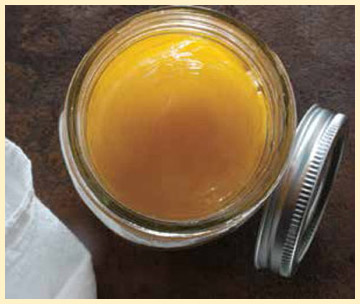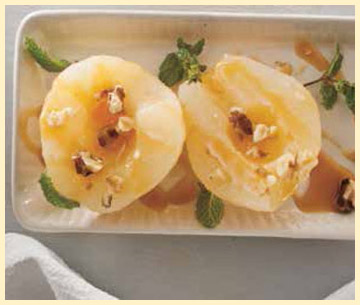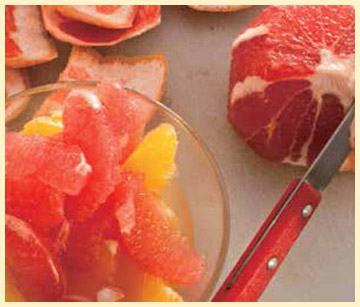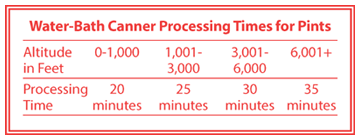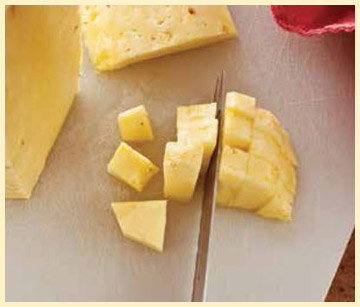PEACHES IN SYRUP
SUN-RIPENED PEACHES CAPTURED AT THEIR JUICIEST MAKE DELIGHTFUL WINTER EATING
Ripe peaches do not store for very long, so canning them at their peak of ripeness allows you to savor that juicy taste for much longer. Choose peaches that are fully tree ripened but that don’t have large bruises or soft spots.
Peaches are best when canned in syrup; this recipe calls for medium-heavy syrup. You can reduce the amount of sugar or can the peaches in water or juice. See recipe variations. Do not use artificial sweeteners.
Freestone peaches slip easily from their pits and golden-fleshed peaches make prettier jars than their lighter-fleshed relatives. Special peach peelers can make removing the soft fuzzy skin easier. Yield: 7 quarts
PEACHES IN SYRUP
Bring a large pot of water to a simmer. Prepare a pot of cold water. Dip peaches in the hot water 1 minute, then dip in the cold water; slip off the skins and discard.
Slice peaches in half; remove pits. Place in mixture of lemon juice or ascorbic acid and water until you are ready to cook, then drain.
Bring sugar and water to a boil. Add drained peaches. Bring to boil. Turn off heat.
Ladle peaches and syrup into hot jars, cut side down, to ½ inch from rim. Remove bubbles, wipe rims, put on lids, and process.
For a lighter syrup, reduce the sugar to 3 cups. This will still make a nice-looking product. You may also use 8 cups unsweetened apple or white grape juice in place of the water. You can omit the sugar entirely and just use water to can peaches, but they won’t look as nice. When you open water-canned peaches, you can add an artificial sweetener.
PRECOOKING
Peaches are precooked to inactivate enzymes that cause discoloration and softness.
Be careful not to overcook, or your peaches will get mushy when processed.
The sugar and water should be vigorously boiling when you add the peaches. Slide the peaches in carefully so hot fluid doesn’t splash up on your hands.
Keep a close watch, and as soon as the fluid is boiling again, shut off the heat.
FILLING JARS
You could actually slice or dice the peaches, but halves look so much prettier in the jars.
Turning the cut sides down and nestling halves on top of each other is the best use of space, and it looks nicer, too.
If the halves are small, you can tuck some halves along the jar sides, cut side in.
Make sure to run a bubble stick through the filled jars before placing the lids. Peach halves can trap air in their hollows.
PEARS IN JUICE
MANY OTHER FRUITS CAN ALSO BE CANNED IN JUICE
Pears are the odd fruit that actually ripen best off the tree. When pears get their mature color, which can be yellow, green, brown, or red, they are picked and allowed to soften for a few days. Asian pears are round like apples and never get as soft as regular pears.
Bartlett pears are top canning pears, but many other varieties are also good. Tiny canned Seckel pears make attractive garnishes or additions to salads. Choose pears that are just softening, without large bruises or soft spots, for canning. It takes about 2½ pounds of whole pears to make each quart of canned pears.
Pears contain the sweetest natural sugar, levulose, in a higher concentration than any other fruit. Yield: 7 quarts
PEARS IN JUICE
Wash and peel pears, slice lengthwise, and use melon baller to core; cut into slices.
Put pear slices in a pot with color preservative solution while heating juice.
Bring apple juice to a boil. Drain pears in colander and add. Boil 5 minutes. Turn off heat.
Ladle sliced pears and juice into hot jars to ½ inch from top, remove bubbles, wipe rim, place lids, and process.
Drain and chill canned pears. Save juice. Pour 2 tablespoons caramel ice-cream sauce into saucer; add ½ cup pear slices. Heat ½ cup canned pear juice with 2 teaspoons brown sugar, 1 teaspoon butter, and ⅛ teaspoon cinnamon until bubbly; pour over pear slices. Drizzle more caramel sauce over pears, sprinkle with chopped walnuts. Add whipped cream. Yield: 1 serving
CORING PEARS
Pears can be peeled with a potato peeler or a paring knife. Slice them lengthwise.
To easily remove the core, run a melon baller or small spoon down the middle to scrape out the tough membrane and seeds.
Pears are odd shaped and may look better sliced than halved, and slices may fit into jars better than halves.
Pears darken when exposed to air, so slip them into the color preservative solution as each is sliced.
FILLING JARS
Because pears are firm, dense fruits, they are precooked for 5 minutes in boiling juice before packed into jars.
Once precooking is complete, ladle hot pears into jars right away.
Try to get equal amounts of pear slices and juice into each jar. Fill jars with hot juice up to ½ inch from the jar rim.
Unsweetened white grape juice or pineapple juice can be substituted for the apple juice.
CITRUS IN WATER
THIS RECIPE IS THE LOWEST-CALORIE VERSION OF CANNED FRUIT AND CAN BE ADAPTED FOR MANY FRUITS
If you are lucky enough to live in a warm area of the United States, you may have orange trees in the back yard instead of apple or peach trees. Or you may have grapefruit, lime, or lemon trees.
Like other fruits, citrus can be canned when it is abundant and used at other times of the year. This is the lowest-calorie version of canned fruit, as it is canned in water. Most fruits can be canned in a similar manner. Citrus can also be canned in juice or sugar syrup.
Choose citrus fruits that are fully ripe for canning. The best way to know if they are ripe is to taste them. The fruit should have no large bruises.
CITRUS IN WATER
Wash citrus in warm water. Remove all peels. Remove all the white fibrous material (albedo) on the outside of the fruit.
Section the citrus or cut lemons and limes into rounds. Bring water to a boil, about 1 cup per pint.
Fill jars loosely with fruit. Don’t compress or squeeze. Leave ½ inch to rim.
Pour boiling water over fruit to fill spaces and cover fruit. Remove bubbles, wipe rims add lids, and process.
To keep the calories down or to avoid white sugar, most fruits can be canned in water. Pears, cherries, plums, and most berries can be canned in water. Apples, peaches, and grapes keep their color and texture better in juice or syrup but can also be canned in water. Cranberries should be canned in syrup. To can in water, prepare the fruit and substitute water for syrup or juice.
PREPARING CITRUS FRUIT
Wash the outer peel well before peeling. Remove the entire peel. Pull fruit sections apart.
The white, stringy fibrous material on the inner surface needs to be carefully picked off. It creates a bitter taste when canned.
Use a knife or scissors to trim off the middle, fibrous area—where the seeds are—and remove as many seeds as possible.
Large grapefruit sections can be cut in half. Lemons and limes should be sliced into rounds instead of sectioned.
FILLING JARS
Pack jars loosely with the fruit sections or rounds to about the jars’ shoulders. Leave ½-inch headspace.
Don’t compress or mash the fruit Shaking the jars lightly may provide extra room.
If more than one fruit is used, try to arrange equal amounts in each jar. Blood oranges and red grapefruit add color.
Boiling water must cover all the fruit before processing. After removing bubbles, add more water if needed.
CHERRIES IN SYRUP
CHERRIES MAY BE HARD TO PIT, BUT THEY MAKE A WIDE RANGE OF TASTY DISHES
There are sweet dessert-type cherries and tart cherries, and both can equally well. Choose cherries that are fully ripe and don’t hold onto them long before canning.
Tart cherries are generally red, but sweet cherries range from deep red-black to yellow. Heavily bruised, moldy, or bird-damaged cherries should be discarded.
Sometimes cherries are canned with their pits, but to make them recipe ready, most cherries are pitted before canning. If they are not pitted, cherries must have their skin pricked before processing to keep them from bursting.
CHERRIES IN SYRUP
Wash cherries, remove stems, and pit them.
Place cherries in color preservative solution while you bring the water to boil.
Combine sugar and water and bring to a boil; add drained cherries, return to boil, and turn off heat.
Ladle cherries and syrup into jars to ½ inch from rim. Remove bubbles, wipe rim, add lids, and process.
Cherries are high in antioxidants and have many health benefits associated with them. Yield: 9 pints
Single cherry pitters are very inexpensive. (An olive pitter works, too.) If you can’t find one, use the tip of a potato peeler, a small crochet hook, or a nut pick to scrape the pit out. Or use a piece of rigid plastic drinking straw (the reusable kind) to push the pit through the cherry. You can also pull the cherry apart, but those cherries don’t look as nice.
PITTING CHERRIES
Pitting cherries is messy work no matter how you do it. Cherry juice stains, so wear an apron or old clothes.
If you don’t have a cherry pitter, see the tips in the sidebar for homemade tools.
The stem end of pitted cherries will discolor, so as you pit cherries pop them in the color preservative solution.
Half-frozen cherries are easier to pit and are less messy. Set small batches in the freezer for 30 minutes before pitting.
FILLING JARS
Do not cook cherries too long, or they will lose their color and shape; the syrup and cherries need to be brought to just boiling.
You can add a few drops of red food coloring to the cherries before filling the jars if desired.
Try to get equal amounts of cherries and syrup in each jar.
Cherries tend to settle to the bottom if there is too much syrup; if necessary use one less jar so jars look filled.
MIXED FRUIT IN SYRUP
USUALLY KNOWN AS FRUIT COCKTAIL, THIS DISH IS ESPECIALLY POPULAR WITH KIDS
Mixed Fruit in Syrup can be a fun dish for kids or an elegant dessert for guests, depending on the fruits used and the presentation. Consider using some exotic fruits like papaya or star fruit with the com-mon fruits from your garden to make your mixed fruit more exciting. Mixed Fruit in Syrup is also a way to use up small batches of fruit. When using citrus, remove all white tissue from sections.
Usually the fruit for this recipe is cut into small cubes, but you can be creative. It takes 12 cups of peeled and diced fruit to make about 6 pints of mixed fruit. Try to make the blend colorful. Pint jars are recommended. You can also can mixed fruit in apple, white grape, or pineapple juice. Yield: 6 pints
MIXED FRUIT IN SYRUP
Wash, peel, and dice fruit into ½-inch cubes. Leave grapes whole. Place fruit in color preservative solution.
Combine sugar and water in a pot, bring to a boil, and turn off heat.
Pour ½ cup hot syrup into each jar, then drain fruit and add to near top of jar. Push a few maraschino cherries into each jar with a bubble stick.
Fill any space with more syrup to ½ inch from rim, remove bubbles, wipe rim, top with lids, and process.
American: whole seedless green grapes, peaches, pears, pineapple; Tropical: red seedless grapes, pineapple, papaya, tangerine sections, pears; Exotic: star fruit, pineapple, kiwi slices, papaya, whole blackberries, apricots; Patriotic: red seedless grapes, red maraschino cherries, pears, large whole blueberries; Holiday: red tart cherries, green seedless grapes, pears, raspberries, kiwi slices
PREPARING FRUIT
Don’t wash fruit until just before using. Purchased fruits should be washed well and any wax removed with warm, soapy water. Rinse well.
Each type of fruit needs to be peeled and sliced or diced into bite-size pieces.
Grapes can be cut in half if they have seeds and the seeds removed. Seedless grapes can be left whole.
Larger firm fruits like pears and peaches should be used in larger amounts than grapes and berries in the mixes.
ADDING COLOR
Canned commercial maraschino cherries in red or green can be added to make fruit mixes more attractive. Don’t use more than 2 to 3 per jar.
Think about the colors of fruit when blending fruits and strive for a mixture of colors.
Dark red tart cherries, blueberries, and blackberries can be used in small amounts for color.
Push your color accents into filled jars along the sides so the jars look attractive.
SPICED APPLE RINGS
SOMETHING A LITTLE DIFFERENT, BOTH PRETTY AND TASTY
Apples can be canned plain in juice, water, or syrup, but they hold their texture better in syrup. And plain canned apples can be rather bland. This recipe brings a snap to them. Remember to choose firm, small apples about 2½ inches in diameter so your rings will fit in the jars.
This unusual and fun recipe uses a common candy often called Red Hots. They are usually shaped like hearts but may also be round or oblong. They have a strong, fiery cinnamon flavor that combines well with apples.
You can vary this recipe by using pear slices or small Seckel pears cut in half. Small crabapples can be cored and left whole as well. Yield: 9 pints
SPICED APPLE RINGS
Wash apples. Then peel, core, and slice into ½-inch rounds; place in color preservative solution until ready to cook.
Combine sugar, water, vinegar, and cloves in a large pot and bring to a boil; add Red Hots and food coloring (optional).
Simmer and stir 3 minutes, until candy dissolves. Drain apples in colander and add. Cook 5 minutes. Turn off heat.
Transfer rings to jars; pour hot syrup over to ½ inch from rim. Wipe rim, top with lids, and process.
Tart firm apples are better for canning than soft apples. Golden Delicious, McIntosh, Prairie Spy, Rome, Jonathan, Lodi, Cortland, GoldRush, and Honey Gold are some exam-ples. Whitney Crabapples are an excellent size and flavor for spiced whole apples and are pretty ornamental trees, too. Apples don’t ripen once picked, so make sure they are fully ripe for best flavor.
SLICING APPLES
After peeling, use a knife or coring tool to remove the core where the stiff membrane and seeds are located.
Turn the apple on its side and carefully slice it into ½-inch rings. Immediately place the slices into color pre-servative solution.
The spices and candy will change the apple color, so you can omit the color preservative solution, which will result in darker rings.
Widemouthed jars accommodate larger apple rings. Slightly large rings can be bent to fit through jar openings.
CANDY ADDS FLAVOR
The candies give the rings color and a spicy hot flavor. You can also substitute 8 cinnamon sticks and red food coloring for the candy.
Keep the water hot, but don’t allow it to boil as you stir the candies to dissolve them.
Watch the apples carefully as they simmer in the candy mixture. Don’t let them stick to the bottom or sides of the pot.
To fill jars, gently lift the rings with tongs or a slotted spoon so they don’t break.

